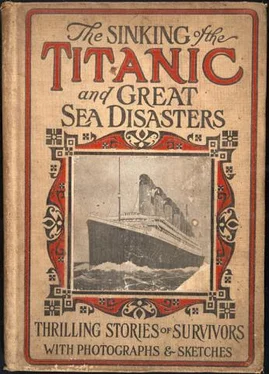Logan Marshall - Sinking of the Titanic and Great Sea Disasters
Здесь есть возможность читать онлайн «Logan Marshall - Sinking of the Titanic and Great Sea Disasters» весь текст электронной книги совершенно бесплатно (целиком полную версию без сокращений). В некоторых случаях можно слушать аудио, скачать через торрент в формате fb2 и присутствует краткое содержание. Год выпуска: 1912, Жанр: Прочая документальная литература, на английском языке. Описание произведения, (предисловие) а так же отзывы посетителей доступны на портале библиотеки ЛибКат.
- Название:Sinking of the Titanic and Great Sea Disasters
- Автор:
- Жанр:
- Год:1912
- ISBN:нет данных
- Рейтинг книги:4.5 / 5. Голосов: 2
-
Избранное:Добавить в избранное
- Отзывы:
-
Ваша оценка:
- 100
- 1
- 2
- 3
- 4
- 5
Sinking of the Titanic and Great Sea Disasters: краткое содержание, описание и аннотация
Предлагаем к чтению аннотацию, описание, краткое содержание или предисловие (зависит от того, что написал сам автор книги «Sinking of the Titanic and Great Sea Disasters»). Если вы не нашли необходимую информацию о книге — напишите в комментариях, мы постараемся отыскать её.
’s demise!
Sinking of the Titanic and Great Sea Disasters — читать онлайн бесплатно полную книгу (весь текст) целиком
Ниже представлен текст книги, разбитый по страницам. Система сохранения места последней прочитанной страницы, позволяет с удобством читать онлайн бесплатно книгу «Sinking of the Titanic and Great Sea Disasters», без необходимости каждый раз заново искать на чём Вы остановились. Поставьте закладку, и сможете в любой момент перейти на страницу, на которой закончили чтение.
Интервал:
Закладка:
With the advent of the nineteenth century a new ideal in naval architecture arose, that of the ship moved by steam-power instead of wind-power, and fitted to combat with the seas alike in storm and calm, with little heed as to whether the wind was fair or foul. The steamship appeared, and grew in size and power until such giants of the wave as the Titanic and Olympic were set afloat. To the development of this modern class of ships our attention must now be turned.
As the reckless cowboy of the West is fast becoming a thing of the past, so is the daring seaman of fame and story. In his place is coming a class of men miscalled sailors, who never reefed a sail or coiled a cable, who do not know how to launch a life-boat or pull an oar, and in whose career we meet the ridiculous episode of the life-boats of the Titanic, where women were obliged to take the oars from their hands and row the boats. Thus has the old-time hero of the waves been transformed into one fitted to serve as a clown of the vaudeville stage.
The advent of steam navigation came early in the nineteenth century, though interesting steps in this direction were taken earlier. No sooner was the steam-engine developed than men began to speculate on it as a moving power on sea and land. Early among these were several Americans, Oliver Evans, one of the first to project steam railway travel, and James Rumsey and John Fitch, steamboat inventors of early date. There were several experimenters in Europe also, but the first to produce a practical steamboat was Robert Fulton, a native of Pennsylvania, whose successful boat; the Clermont, made its maiden trip up the Hudson in 1807. A crude affair was the Clermont, with a top speed of about seven miles an hour; but it was the dwarf from which the giant steamers of to-day have grown.
Boats of this type quickly made their way over the American rivers and before 1820 regular lines of steamboats were running between England and Ireland. In 1817 James Watt, the inventor of the practical steam-engine, crossed in a steamer from England to Belgium. But these short voyages were far surpassed by an American enterprise, that of the first ocean steamship, the Savannah, which crossed the Atlantic from Savannah to Liverpool in 1819.
Twelve years passed before this enterprise was repeated, the next steam voyage being in 1831, when the Royal William crossed from Quebec to England. She used coal for fuel, having utilized her entire hold to store enough for the voyage. The Savannah had burned pitch-pine under her engines, for in America wood was long used as fuel for steam-making purposes. As regards this matter, the problem of fuel was of leading importance, and it was seriously questioned if a ship could be built to cross the Atlantic depending solely upon steam power. Steam-engines in those days were not very economical, needing four or five times as much fuel for the same power as the engines of recent date.
It was not until 1838 that the problem was solved. On April 23d of that year a most significant event took place. Two steamships dropped anchor in the harbor of New York, the Sirius and the Great Western. Both of these had made the entire voyage under steam, the Sirius, in eighteen and a half and the Great Western in fourteen and a half days, measuring from Queenstown. The Sirius had taken on board 450 tons of coal, but all this was burned by the time Sandy Hook was reached, and she had to burn her spare spars and forty-three barrels of rosin to make her way up the bay. The Great Western, on the contrary, had coal to spare.
Two innovations in shipbuilding were soon introduced. These were the building of iron instead of wooden ships and the replacing of the paddle wheel by the screw propeller. The screw-propeller was first successfully introduced by the famous Swede, John Ericsson, in 1835. His propeller was tried in a small vessel, forty-five feet long and eight wide, which was driven at the rate of ten miles an hour, and towed a large packet ship at fair speed. Ericsson, not being appreciated in England, came to America to experiment. Other inventors were also at work in the same line.
Their experiments attracted the attention of Isambard Brunel, one of the greatest engineers of the period, who was then engaged in building a large paddle-wheel steamer, the Great Britain. Appreciating the new idea, he had the engines of the new ship changed and a screw propeller introduced. This ship, a great one for the time, 322 feet long and of 3443 tons, made her first voyage from Liverpool to New York in 1845, her average speed being 12¼ knots an hour, the length of the voyage 14 days and 21 hours.
By the date named the crossing of the Atlantic by steamships had become a common event. In 1840 the British and Royal Mail Steam Packet Company was organized, its chief promoter being Samuel Cunard, of Halifax, Nova Scotia, whose name has long been attached to this famous line.
The first fleet of the Cunard Line comprised four vessels, the Britannia, Acadia, Caledonia and Columbia. The Unicorn, sent out by this company as a pioneer, entered Boston harbor on June 2, 1840, being the first steamship from Europe to reach that port. Regular trips began with the Britannia, which left Liverpool on July 4, 1840. For a number of years later this line enjoyed a practical monopoly of the steam carrying trade between England and the United States. Then other companies came into the field, chief among them being the Collins Line, started in 1849, and of short duration, and the Inman Line, instituted in 1850.
We should say something here of the comforts and conveniences provided for the passengers on these early lines. They differed strikingly from those on the leviathans of recent travel and were little, if any, superior to those on the packet ships, the active rivals at that date of the steamers. Then there were none of the comfortable smoking rooms, well-filled libraries, drawing rooms, electric lights, and other modern improvements. The saloons and staterooms were in the extreme after part of the vessel, but the stateroom of that day was little more than a closet, with two berths, one above the other, and very little standing room between these and the wall. By paying nearly double fare a passenger might secure a room for himself, but the room given him did not compare well even with that of small and unpretentious modern steamers.
Other ocean steamship companies gradually arose, some of which are still in existence. But no especial change in ship-building was introduced until 1870, when the Oceanic Company, now known as the White Star Line, built the Britannic and Germanic. These were the largest of its early ships. They were 468 feet long and 35 feet wide, constituting a new type of extreme length as compared with their width. In the first White Star ship, the Oceanic, the improvements above mentioned were introduced, the saloons and staterooms being brought as near as possible to the center of the ship. All the principal lines built since that date have followed this example, thus adding much to the comfort of the first-class passengers.
Speed and economy in power also became features of importance, the tubular boiler and the compound engine being introduced. These have developed into the cylindrical, multitubular boiler and the triple expansion engine, in which a greater percentage of the power of the steam is utilized and four or five times the work obtained from coal over that of the old system. The side-wheel was continued in use in the older ships until this period, but after 1870 it disappeared.
It has been said that the life of iron ships, barring disasters at sea, is unlimited, that they cannot wear out. This statement has not been tested, but the fact remains that the older passenger ships have gone out of service and that steel has now taken the place of iron, as lighter and more durable.
Something should also be said here of the steam turbine engine, recently introduced in some of the greatest liners, and of proven value in several particulars, an important one of these being the doing away with the vibration, an inseparable accompaniment of the old style engines. The Olympic and Titanic engines were a combination of the turbine and reciprocating types. In regard to the driving power, one of the recent introductions is that of the multiple propeller. The twin screw was first applied in the City of New York, of the Inman line, and enabled her to make in 1890 an average speed of a little over six days from New York to Queenstown. The best record up to October, 1891, was that of the Teutonic, of five days, sixteen hours, and thirty minutes. Triple-screw propellers have since then been introduced in some of the greater ships, and the record speed has been cut down to the four days and ten hours of the Lusitania in 1908 and the four days, six hours and forty-one minutes of the Mauretania in 1910.
Читать дальшеИнтервал:
Закладка:
Похожие книги на «Sinking of the Titanic and Great Sea Disasters»
Представляем Вашему вниманию похожие книги на «Sinking of the Titanic and Great Sea Disasters» списком для выбора. Мы отобрали схожую по названию и смыслу литературу в надежде предоставить читателям больше вариантов отыскать новые, интересные, ещё непрочитанные произведения.
Обсуждение, отзывы о книге «Sinking of the Titanic and Great Sea Disasters» и просто собственные мнения читателей. Оставьте ваши комментарии, напишите, что Вы думаете о произведении, его смысле или главных героях. Укажите что конкретно понравилось, а что нет, и почему Вы так считаете.












